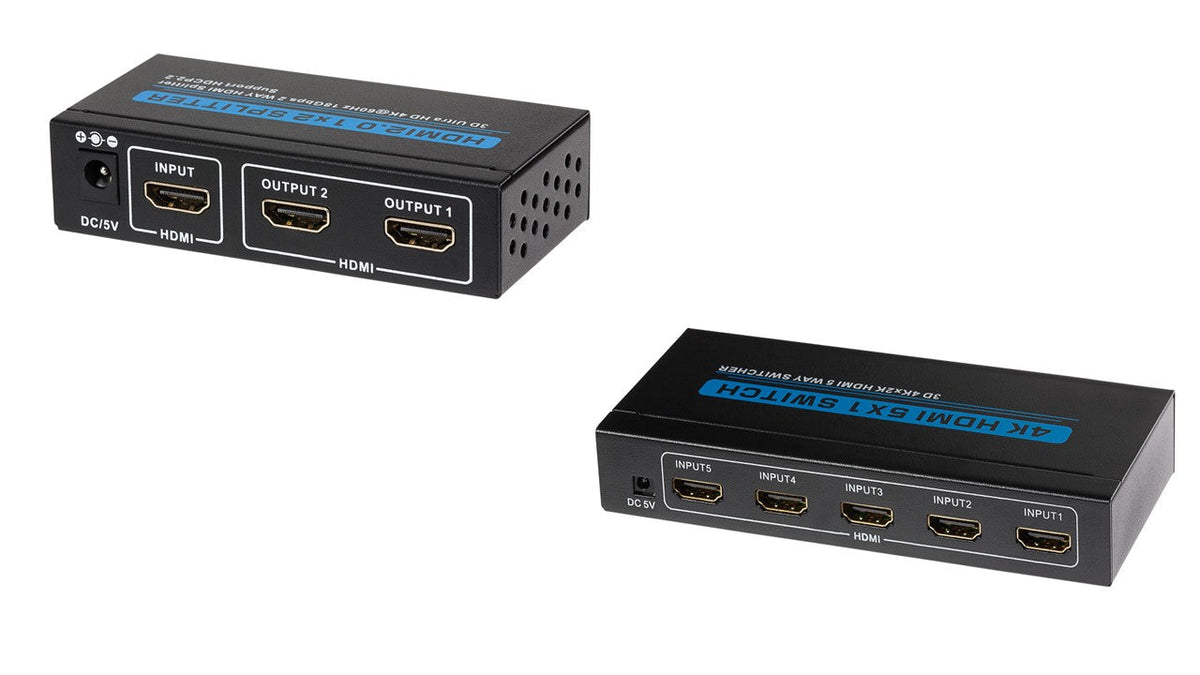
What is the difference between HDMI splitters & HDMI switches?
|
|
Time to read 3 min
|
|
Time to read 3 min
If you’re tired of having to constantly swap HDMI cables between sources or need to show the same signal across multiple displays, an HDMI splitter or an HDMI switch could be exactly what you’re looking for. But what is the difference between HDMI splitters & switches? What do they do? And which one do you need?
An HDMI switch is an ideal choice if you need to connect multiple devices to the same TV or monitor. Maybe you’ve got an Xbox, a PlayStation, a streaming stick and even a DVD player (for retro value), but you don’t have enough HDMI ports available to connect them all. You don’t need to manually unplug one to use another – simply use an HDMI switch!
They allow users to connect multiple HDMI source devices, such as gaming consoles, Blu-ray players, streaming devices, and cable boxes, to a single HDMI input on their TV or monitor. HDMI switches feature multiple HDMI inputs and a single HDMI output, so users can easily switch between different source devices without having to constantly swap cables. With their plug-and-play functionality and automatic switching capabilities, HDMI switches provide a convenient and streamlined solution for managing multiple HDMI devices and maximizing the functionality of home entertainment systems. Whether in a living room setup or a professional AV environment, HDMI switches offer flexibility, convenience, and seamless connectivity for users looking to simplify their multimedia setups.
Need to show the same output across multiple screens? An HDMI splitter is the way to go. It accepts one input source and shows the content across more than one television or monitor.
From creating multi-display setups to sharing console gameplay across two or more screens, it’s a simple and convenient solution that won’t leave you tangled up in multiple HDMI cables worried about which device is plugged into which display.
These devices take the HDMI output from a source device such as a Blu-ray player, gaming console, or media streaming device and split it into multiple identical signals, allowing them to be transmitted to multiple displays or monitors. HDMI splitters are widely used in various settings, including home theaters, conference rooms, and digital signage installations, where multiple displays need to receive the same content simultaneously. With their plug-and-play functionality and support for high-definition resolutions, HDMI splitters provide a simple and cost-effective solution for sharing content across multiple screens, ensuring a seamless viewing experience for users.
The only other major factor to consider is the resolution you’ll be working with. Make sure you check whether the HDMI splitter or switch can handle Full HD or 4K Ultra HD visuals so there’s no loss in quality.
HDMI splitters and HDMI switches are both useful tools for managing multiple HDMI devices, but they serve different purposes. HDMI splitters take a single HDMI input and split it into multiple identical outputs, allowing the same content to be displayed on multiple screens simultaneously. This is useful in scenarios where the same content needs to be distributed to multiple displays, such as in a home theater or digital signage setup. On the other hand, HDMI switches allow users to connect multiple HDMI source devices to a single HDMI input on a TV or monitor. Users can then easily switch between different source devices, selecting which one to display on the screen. HDMI switches are ideal for situations where space is limited or when users want to avoid constantly swapping cables. In summary, HDMI splitters duplicate the same signal to multiple displays, while HDMI switches allow users to select between multiple input sources for display on a single screen.
You can check out our full collection of HDMI Splitters & Switches here, so explore our range and create your ideal AV setup at home or in the office.
HDMI Switches: Allow connecting multiple HDMI source devices to one TV or monitor, useful for managing devices like gaming consoles and streaming sticks without constantly swapping cables.
HDMI Splitters: Take one HDMI input and display it across multiple screens, ideal for scenarios where the same content needs to be shown on multiple displays, such as in home theatres or digital signage setups.
An avid gamer from a young age, Jon has dabbled in gaming journalism and dedicates much of his spare time to this hobby. He also has an interest in music, playing bass guitar in a rock covers band.
Having previously worked as a copywriter with another electronics retailer, he was eager to join Maplin with their new online venture. In addition to writing blogs, Jon also works on many of the website's landing pages and adding new tech to the range.

